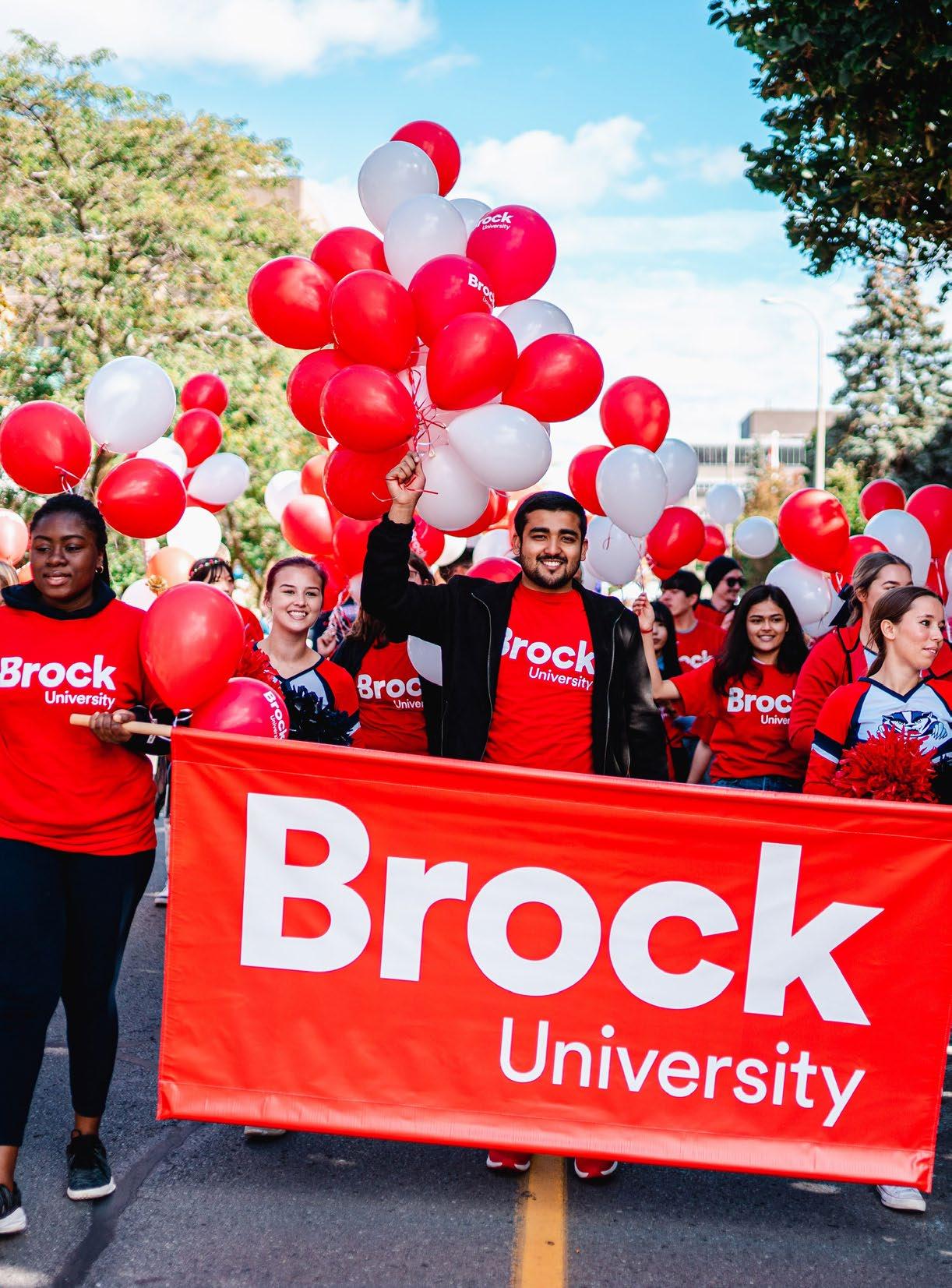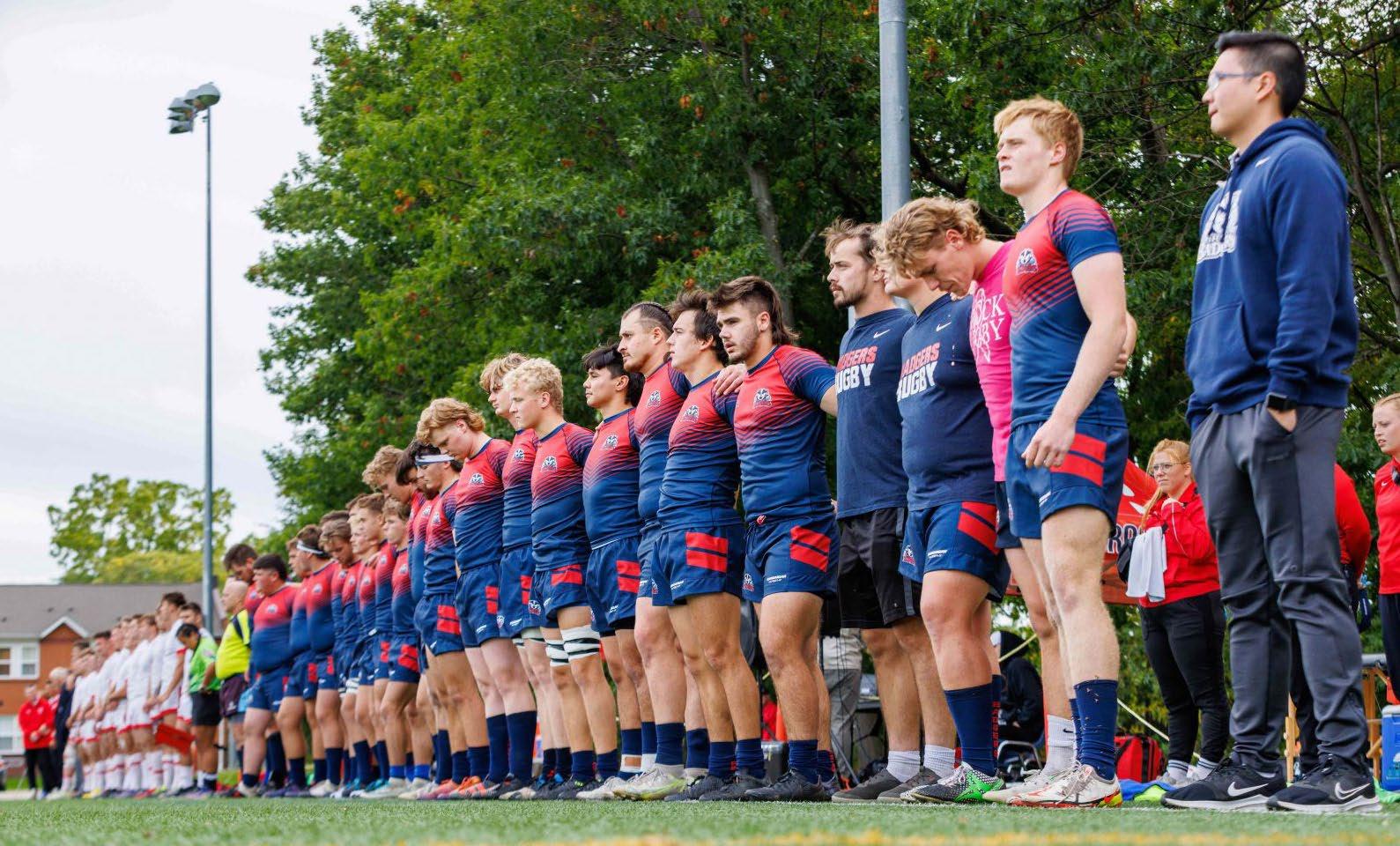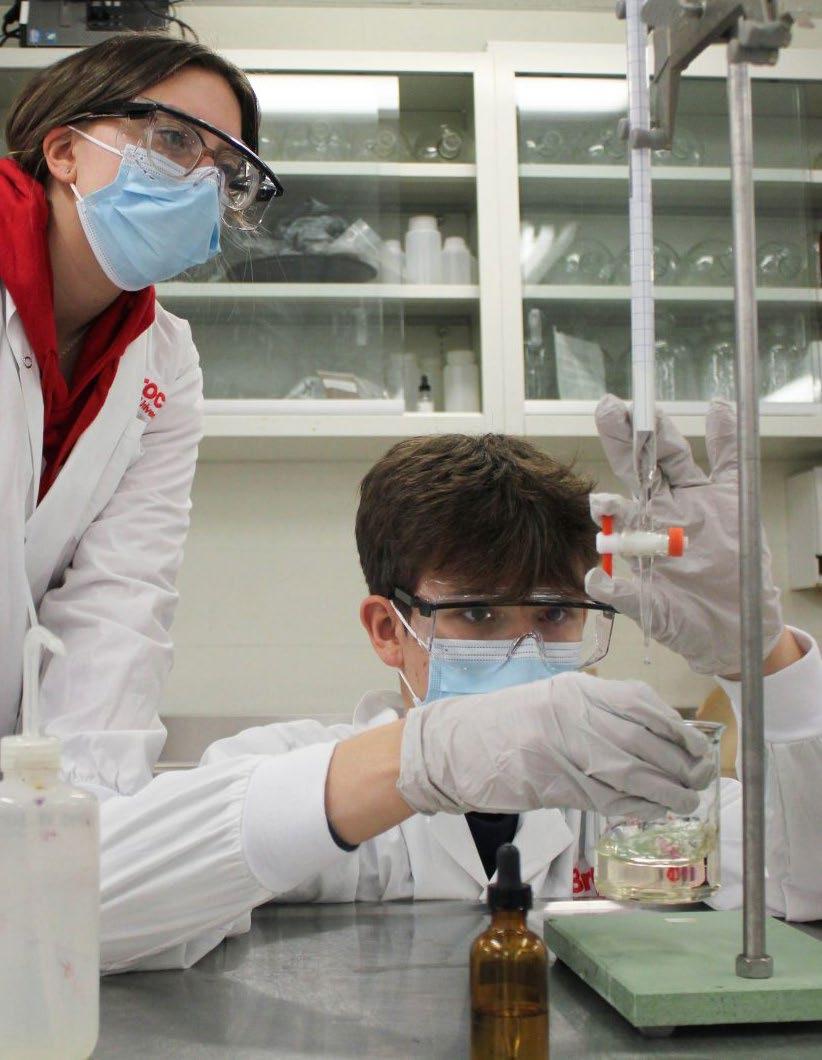Trimester 2 Report
September 1, 2022 to December 31, 2022










September 1, 2022 to December 31, 2022









Brock is projecting a remaining mitigation target of $0.3 million to balance operations for the fiscal year. This is an extraordinary result achieved by the collective efforts of our Brock community. From the approved budget that required a $3.0 million mitigation target, to the trimester one forecast that estimated a year-end funding mitigation target of $13.4 million, we thank our community for this achievement.
Overall student fees are forecasted to be down versus budget by $16.5 million or 8.1 per cent due to lower anticipated student enrolment of which $13.0 million is associated with lower international enrolment. International enrolment has suffered across the sector due in large part to significant delays in international student VISA processing by the Federal Government. At the end of 2022 over 75,000 VISA applications for students hoping to enrol in a Canadian University were not processed. Assuming an average tuition rate of $35,000, this represents lost tuition revenue to the Canadian University sector of over $2.6 billion.
Ancillary Services is forecasting a net profit of $5.1 million, which includes a funding contribution to the University’s capital project budget of $4.0 million; thus, totalling a $9.1 million contribution to the University’s academic and research operations. Ancillary Services profit is forecasted to exceed the budgeted profit of $3.9 million due to cost savings which also offset the slightly lower than budgeted revenue mainly in the campus store that is forecasting sales to be $0.9 million less than budget. While enrolment remains a key driver for Ancillary revenues, equally important is the need to have students on campus with-in person classes. While there are benefits to pedagogy for providing online capacity, without a core in-person model, operations like parking, dining and campus store will struggle to achieve revenue targets that support academic and research programs.
Investment income is ahead of budget by $2.7 million due to the significant rise in interest rates. Over the past twelve months the prime rate has increased from 2.45 per cent to 6.45 per cent.
Budget controls to manage personnel costs have been in place since the trimester one forecast. Personnel costs, which represent approximately 2/3rds of the University expenditures, have been mitigated with a forecasted $12.2 million savings compared to budget. Some major savings in the non-personnel category relate to student scholarships and fellowships of $2.9 million due to the lower student enrolment and $3.6 million currently remaining unallocated from the operating strategic reserve established as one per cent of revenue for contingency or strategic needs in the budget. The $1.66 million in capital projects placed on hold at trimester one has been included as funded in this forecast; thus, the full capital project plan for 2022-23 will be funded and completed.
The remaining mitigation of $0.3 million has to be achieved during the final months of the year. While we experienced strong cost containment for another year, we recognize that Brock, along with the entire sector, remains under significant financial pressures. With limited flexibility on revenues, ongoing efforts to manage costs while balancing investments in future revenue generating programs will be essential to Brock’s future sustainability.
This report contains certain forward-looking information. In preparing the Trimester 2 Report, certain assumptions and estimates were necessary. They are based on information available to management at the time of preparing the forecast. Users are cautioned that actual results may vary.

Throughout the text in this report, financial values have been rounded to the nearest thousand unless otherwise stated.



Photo collage on page 3:
Students Experience: SEPTEMBER 02, 2022 – Brock University welcomed a new group of International Student Ambassadors for the 2022-23 academic year.
Research: DECEMBER 01, 2022 –Brock University Assistant Professor of Chemistry Vaughn Mangal (left) and fourth-year Chemistry student Adithya Sethumadhavan (right) test water samples collected to study the impact of agricultural practices on nearby water sources.
Community Engagement: OCTOBER 06, 2022 – High school students jumpstart university journey with Faculty of
program.
2022
Phyllis Webstad, and Director of Hadiyaˀdagénhah First Nations, Métis and Inuit Student Centre Cindy Biancaniello hold the Survivors’ Flag, which was raised during Webstad’s visit to Brock.



The following table illustrates the trimester two revenue and expense forecast for the University compared to budget. The information is presented on a funding basis, which represents committed cash, and based on the audited financial statements prepared in accordance with accounting standards for not for-profit organizations (NFPS). A reconciliation of the two presentations can be found on page 20
(1) Included in the NFPS forecasted deficit is spending from strategic reserves of $3.9 million for new initiatives.

The 2022-23 trimester two forecast projects a remaining mitigation target of $0.3 million. This fiscal position is a notable achievement given the $13.4 million mitigation target identified at trimester one. In the past, in-year savings and underspending have allowed us to mitigate revenue challenges. Other operating expense savings are historically realized during the final trimester of the year as compared to costs anticipated at trimester two.
Input and recommendations for future budget decisions are encouraged and may be emailed to budgetreport@brocku.ca




As shown in Figure 2, overall revenue is forecast at $366.9 million versus the budget of $390.1 million, showing a variance of $23.2 million, driven mainly by forecasted shortfalls in student fee revenue offset by gains in grant revenue and investment income. These variances will be discussed in the following sections.




As shown in Figures 3 and 4, overall enrolment is forecast to be lower than budget, with 919 less students. All student enrolment is not equal when considering the impact to revenue. It is important to note that research-based graduate programs are generally net neutral to the budget as the tuition revenue is offset by fellowships and other student funding.
The lower enrolment forecast translates into overall student fee revenue showing a negative variance to budget of $16.5 million. Much of the decline versus budget is seen in international tuition, in both undergraduate ($9.9 million lower that budget) and graduate ($3.1 million lower than budget) as shown in Figure 5. This decrease is mainly due to international students continuing to experience delays in receiving study permits from the Federal Government. Brock is also currently forecasting a shortfall of $3.1 million in domestic tuition.
As shown in Figure 5, the fee revenue forecast is $0.4 million below budget driven by co-op fees resulting from lower enrolment and carry through in certain co-op programs, as well as lower than budgeted ISP Business English fees. Note, all tuition is reported in the University Global responsibility centre except for Continuing Teacher Education, Adult Education and Intensive and Short-term English Language Programs.
1) Represents student headcount full-time (FT) and part-time (PT). For a definition refer to pg 88 of the 2022-23 Budget Report. The enrolment forecast used for the budget and forecast is 'all-in' and includes letter of permissions, non-degree students, auditors, additional qualifications, and certificates. These are excluded in the 'degree-seeking only' enrolment as presented by the Office of the Registrar.
Figure 7 details the forecast for grant revenue as compared to the budget. Most of the Ministry of Colleges & Universities (MCU) operating grants are forecasted to be consistent with budget with a few exceptions.
The increase in the Special Purpose Operating Grant Envelope of $0.5 million versus budget includes additional funding for the Accessibility Fund for Students with Disabilities and growth in several mental health grants. The growth in the Other MCU and specific purpose grants is driven a $0.9 million increase to the Provincial Facilities Renewal Program (FRP) which supports deferred maintenance projects on campus. Brock now receives $3.85 million in FRP funding which funds a portion of the $8.9 million deferred maintenance budget for 2022-23. Other favourable grant variances include funding from agencies including Co-operative Education and Work-Integrated Learning Canada (CEWIL Canada) and Global Skills Opportunity, as well as a forecasted increase to the Research Support fund grant.

Other revenue, as shown in Figure 8, is forecast to be $57.1 million, $5.1 million less than the budget of $62.2 million. The lower asset sale revenue is driving the variance to forecast. $7.4 million of asset sale revenue is accrued into next fiscal year (2023-24) to align with the change in timing of receiving the cash proceeds as a result of the renewal of the Hamilton Campus sale leaseback for an additional year. This revenue is fully offset in inter-fund expenses as the proceeds of sale are restricted for future use; thus, this has no net impact to the funding results. Investment income is ahead of budget by $2.7 million due to the significant rise in interest rates, which will be discussed in the Treasury section of this report.
Ancillary Services were hit hard by the global pandemic given that most revenues are generated from students physically being on campus and utilizing services such as parking, residence, food, and campus store. Although ancillary revenue is forecasted to be lower than budget, mainly in the campus store that is forecasting sales to be $0.9 million less, Ancillary Services is forecasting a net profit of $5.1 million. This net contribution exceeds the budget of $3.9 million, and also includes a funding contribution to the University’s capital project budget of $4.0 million. The ancillary surplus is driven by parking services contributing $2.6 million, residence contributing $1.9 million, with the remaining profit from dining, conference services and the campus store.




Our people are what make everything possible at our University. Figure 9 below illustrates personnel costs in aggregate by personnel group. Overall personnel costs are expected to be under budget by $12.2 million. This savings materialized in ongoing personnel groups through ongoing strategies that have been utilized to address budget mitigation targets. Other temporary personnel costs are forecasted higher than budget driven by nonunion instructors and part-time costs.
SEPTEMBER 14, 2022: Student Advisor Brendan Burke (BPH ’19) sits in front of flags that are symbolic to First Nations, Métis and Inuit nations in Brock’s newly renamed Hadiyaˀdagénhahs First Nations, Métis and Inuit Student Centre.





Total operating costs are forecasted to be $133.2 million as compared to a budget of $146.9 million, which represents a decrease from budget of $13.7 million. Student scholarships and fellowships are forecasted lower than budget by $2.9 million due to the lower student enrolment. Purchased services are forecasted less than budget by $1.5 million, included in this savings is a $0.3 million reduction in outsourced legal investigations for Human Rights and Equity as well as savings of $0.8 million in international student recruitment fees. Included in the budgeted other operating costs were $3.9 million of uncommitted strategic/discretionary funds, with $3.6 million currently remaining unallocated which is being used as mitigation savings as part of the forecast. Savings are also forecasted in utilities as well as Campus Store cost of sales.
Figure 11 on the following page details the funding by responsibility centre by grouping the forecast and budget into one of the following categories: Teaching Faculties, Academic Support, Student Specific, Shared Services, Ancillary, Space and Global. Please note that Figure 11 includes certain reclassifications to the 2022-23 budget as compared to the figures presented in the 2022-23 Budget Report. All reclassifications will be fully reconciled in the future 2023-24 Budget Report, noting the changes did not impact the net reported budget.
Ancillary Services forecasted a net contribution of $5.1 million, which is $1.2 million greater than the 2022-23 budget. Significant savings were realized in many other units throughout the University including the Faculties, Information Technology Services, and Student Wellness and Accessibility to name only a few. Included in the Research Services budget is faculty recruitment and start-up costs which support faculty research programs. Start-up costs are over budget due to faculty recruitment.
SEPTEMBER 22, 2022: Fourth-year Brock Nursing studentFigure 11 details the funding budget by responsibility centre, where all personnel costs, operating costs and revenue have been grouped by their responsibility centre, which in turn are grouped into one of the following categories:
Space and Global.
Figure 11: Funding budget by responsibility centre
(1) Includes the following: the offices of the President; the Provost and Vice-President, Academic; the Vice-President, Administration; the Vice-President, Research; the Vice-Provost and Associate Vice President, Academic; Associate Vice-President, Students; the Vice-Provost, Indigenous; Vice-Provost, Teaching and Learning; the Associate Vice-President Advancement and External Relations, as well as the operating costs of the Board of Trustees
SEPTEMBER 24, 2022: Brock University alumni joined current staff, faculty and students during the Niagara Grape and Wine Festival’s Grande Parade. Participation in the parade was one of many ways alumni were invited to get involved as part of Brock’s Homecoming celebration.


Government of Canada ten-year bond yield was 3.3 per cent at Dec. 31, 2022 (1.4 per cent at Dec. 31, 2021). This compares to the yield on the operating investment portfolio of 4.45 per cent with an average duration of 7-months (1.05 per cent yield and 5-month average duration at the same time last year). Scotiabank prime rate was 6.45 per cent on Dec. 31, 2022 (2.45 per cent at the same time last year). Yield on cash balances and short-term investments is linked to the prime rate, prime minus 165 basis points on cash, and prime minus 150 basis points on the 30 day hold investment account. Yields have been steadily increasing throughout 2022. Guaranteed Investment Certificates (GIC) investments are being reintroduced into the portfolio with improvements in rates. The laddered GIC strategy(1) was paused since the onset of the global pandemic due to low interest rates. The summary of investment holdings as of Dec. 31, 2022 is shown in Figure 15. Figure 13 outlines monthly investment income performance compared to 2021-22. As detailed


in Figure 12, operating investments have achieved 215 per cent of budget as we reach 67 per cent of the way through the fiscal year due to the positive variance on interest rates. The current forecast has operating investment income, not including the sinking fund, exceeding budget by $2.7 million.
The sinking fund has experienced significant volatility during the first eight months of fiscal 2022-23 generating an annualized 0.03 per cent loss (12.35 per cent gain at the same time last year). Short-term volatility is common and expected with this fund. We continue to support this fund as a long-term investment strategy to fund the 2045/2060 payout of the University's two debentures and the employee future benefits reserve. The fund requires a 5.0 per cent annual rate of return for the series A $93 million debenture and a 5.2 per cent rate of return for the series B $125 million debenture to achieve its goal and this rate of return is aligned with the asset mix and skill of the fund manager.
(1) An investment strategy in which GICs that have different maturities are assembled into a portfolio.
(1) Brock currently has 3 externally restricted segregated trust investments not included in the figures above.
OCTOBER 03, 2022: Brock’s new brand positioning and visual identity – which emphasize the ability to “break through” at Brock – is the result of more than a year of community consultation and is aimed at enhancing the University’s reputation across Canada and around the world.


In photo, Brock University’s Student Recruitment team unveiled its newly updated fair booth at the Ontario Universities’ Fair in Toronto.

Future debt maturities are noted in Figure 16. Brock secured additional debt financing of $15.5 million on June 27, 2022 to fund the acquisition of 3401 Schmon Parkway from Enbridge Inc. The loan includes a fixed interest rate of 3.91 per cent through an interest rate swap agreement, locked in for 5 years, amortizing over a fifteen-year period. The acquired property is 8.16 acres of land, with an 86,591 sq. ft. commercial building on the site. The strategic acquisition was made to address the growing space requirements
of the University with usage being determined through a renewed space master planning process underway. Brock also repaid the remaining $20.6 million balance outstanding on the loan for the Roy and Lois Cairns Health and Bioscience Research Complex which matured on July 4, 2022. The debt forecast is within financial metric ranges of the University’s current credit rating; however, total debt outstanding is approaching the upper limits of the A rating. DBRS Morningstar currently rates Brock’s credit rating at A (high) with Stable trends.
(1) Fiscal full-time enrolment (FFTE). For a definition, refer to page 88 of the 2022-23 Budget Report. Note: April 30, 2022 FFTE figures have been updated and decreased by 91 as they had to be resubmitted to the Ministry following the enrolment audit. Forecasted FFTEs beyond 2022 have not been updated from the 2022-23 Fiscal Framework.



2021.




The actuarial valuation on the pension plan completed as at July. 1, 2022, indicated the plan was 99 per cent funded on a going-concern basis (98 per cent as at Jan 2020 valuation) and 105 per cent on a solvency basis (106 per cent as at Jan 2020 valuation). The going concern deficit improved mainly due to higher interest rates increasing the discount rate that reduces the present value of the plan liabilities. The actuary sets the expected rates of returns for asset mix based on industry best practices guided by the Canadian Institute of Actuaries. The University has no control or influence over these assumptions used by the actuary. The going concern deficit of $5.3 million ($12.7 million as at Jan 2020 valuation) requires special payments into the plan of $0.5 million representing an annual savings of $1.0 million compared to the previous valuation. In addition, current service cost and money purchase payments for the plan total $14.1 million for a total cost to the University of $14.6 million annually. Employees also contribute to the money purchase component of the plan (defined contribution) an additional $8.2 million resulting in an employer to employee funding ratio of 1.8 to 1.0.

The investment returns and investment balance for the last eight years are detailed in Figure 19. Additional information on the pension plan may be found at brocku.ca/about/university-financials/#auditedp ension-statements




University infrastructure investment is ongoing as we invest in new and current space and technology to support and improve the student, academic and research experience. Figure 20 illustrates the number of open capital and related projects. These projects include all 2022-23 projects as well as uncompleted prior year projects. Note: the majority of the 2022-23 projects were opened prior to May 1, 2022. Figure 21
illustrates the activity to Dec. 31, 2022 with respect to the type and dollar amount of projects. It was noted at trimester one that $1.66 million in capital projects were identified that could be deferred and used for mitigation, if required. This mitigation strategy was not utilized as part of the trimester two forecast. The established 2022-23 capital and related projects budget is $14.82 million (Information Technology Services Projects – $5.33 million; Facilities Management Projects – $9.49 million).
(1) Funding revenue represents total expected funding and cash received. This amount is not reflective of all funding received to date.
Brock University uses trimester reporting to match financial reporting with the inherent timing of the operations of Brock. Figure 22 details the in-year activity and forecast on a funding basis for Trimester 2.




Throughout this report financial information has been reported on a funding basis (sometimes referred to as committed cash basis). Figures 23 and 24 detail the entries and reclassifications required to convert the funding budget to be in accordance with the Canadian accounting standards for not-for-profit organizations (NFPS). Please refer to page 90 and 91 of the 2022-23 Budget Report for detailed explanations of all the
adjustments, reclassifications and eliminations. The adjustments, reclassifications and eliminations for the 2022-23 forecast were consistently applied with those of the 2022-23 budget with the following changes: adjustments #2 and #13 were added representing the estimated student fees for capital and the estimated spending in the strategic funds and the remaining adjustments were updated based on estimates for trimester two. It is interesting to note that Brock is the only DBRS rated University that fully reconciles and converts budget to NFPS.
NOVEMBER 28, 2022: Brock University is among 25 organizations that have been selected as HamiltonNiagara’s Top Employers for 2023.






NOVEMBER 16, 2022: Brock University Assistant Professor of Computer Science and Biological Sciences Yifeng Li has been named Canada Research Chair in Machine Learning for Biomedical Data Science for his work using artificial intelligence and machine learning for drug development.

Figure 25 outlines internally restricted reserve balances that have been established for strategic priorities. As at Dec. 31, 2022, Brock has $39.2 million in unspent research, professional development and strategic fund support dollars for faculty and other units including the President, Provost and Vice-President, Academic, Vice-President, Research, Vice-President, Administration and Faculty Deans. This amount compares to $37.1 million available in the same accounts at this time last year. These balances are not reduced to account for future commitments.
(1) Allocated through the revenue and expense allocation model.






 DECEMBER 13, 2022: Thorold Secondary School students Samantha Rocco (left) and Elijah Cosby perform a titration on an apple juice sample in the testing portion of the Oenology and Viticulture Tasting and Testing Lab.
DECEMBER 13, 2022: Thorold Secondary School students Samantha Rocco (left) and Elijah Cosby perform a titration on an apple juice sample in the testing portion of the Oenology and Viticulture Tasting and Testing Lab.
Strategic Priorities












